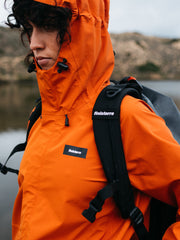Underwater Update | Autumn 2021
10.12.21
4 min read
Words by Dr Richard Lilley (Project Seagrass) & Dr Chris Laing (University of Exeter)
Images courtesy of The Ocean Agency
The headline event for our oceans this Autumn was COP26 in Glasgow. In my opinion COP26 delivered a mixed bag of results. Progress was made (certainly more than I had expected) but certainly not enough to satisfy the science on climate change, and in the end, that is really all that matters, isn’t it? We simply can’t compromise or negotiate with the laws of physics. However, if you look beyond the government announcements and the major COP26 headlines, what was noticeable (particularly in the fringe events) was the growing interest in Nature Based Solutions and Blue Carbon. There has undoubtably been a momentum shift this year towards putting our oceans at the heart of the marine conservation conversation, and frankly it’s about time!
But before I go on let’s take a moment to break down the jargon. What was COP26, what are Nature Based Solutions and what is Blue Carbon?
COP26
For nearly three decades the UN has been bringing together almost every country on earth for global climate summits – called COPs – which stands for ‘Conference of the Parties’. In that time climate change has gone from being perceived as a fringe issue to what is now a full-blown emergency. COP26 represents the 26th of these annual summits and was held in Glasgow from 31st October to 12th November. Next year COP27 will be held in Sharm El-Sheikh, Egypt from 7-18 November 2022.
Nature Based Solutions
Nature-based Solutions (NbS) are defined as “actions to protect, sustainably manage, and restore natural or modified ecosystems, that address societal challenges effectively and adaptively, simultaneously providing human well-being and biodiversity benefits”. OK, well I’m not sure that definition helps entirely, so let’s strip it back to a philosophy of ‘putting nature back’. It’s not rocket science, but when we restore nature, we bring back ALL the benefits it provides; and of particular interest in the COP26 context is the capacity for nature to absorb and store carbon.
Blue Carbon
Blue Carbon is the term used to refer to the carbon stored in coastal and marine ecosystems. The sediments beneath aquatic and terrestrial vegetation provide an efficient means of storing carbon from the atmosphere over long periods and as such, many of the habitats these form are being considered as key potential Nature Based Solutions to climate change. There has been a lot of interest to date in terrestrial carbon capture, most notably, planting trees on land, but for a long time restoring coastal ecosystems has been largely ignored. However, the question being asked right now is, could the restoration of coastal and marine systems (hence ‘Blue’) be an effective way to store carbon and therefore tackle the climate crisis? The early signs are encouraging…
Take a walk around the Green Zone at COP26 and Nature Based Solutions were being promoted everywhere.
So, let’s start this Blue Carbon blog with an ecosystem close to my heart and in a location close to home – Cornwall’s seagrass meadows!
Besides being one of the most progressive councils around, why is it that Cornwall Council has funded an in-depth blue carbon study of its seagrass meadows? Well, it’s to gain a better understanding of their draw down potential and ability to act as a natural climate solution.
In 2016 Cornwall Council developed their Environmental Growth Strategy, which aims to allow nature to thrive and in so doing so, encourage natural climate solutions. What is special about this strategy is that it includes both marine and terrestrial habitats. The Southwest is a UK stronghold for the dominant temperate seagrass species Zostera marina and the Fal and Helford estuaries combined have around 170 ha of beds alone. This is one of the many reasons it has been a designated Special Area of Conservation (SAC) for two decades and why it was the focus of a project to understand its Blue Carbon stocks. This seagrass, commonly known as eelgrass, grows in close proximity to intense anthropogenic pressures and, like much of the UK, has suffered habitat loss in the last 100 years.
Funded by the council, researchers at the University of Exeter, Cornwall Campus are surveying the subtidal and intertidal seagrass beds around the SAC to collect cores for sediment carbon estimates and mark plants to measure their growth rate. Threats like reductions in water quality and damage from recreational boating will be quantified and a nature recovery plan, informed by carbon drawdown potential, will result. With this information, the council aim to protect these sites further and manage threats to allow their extents to grow, at the same time creating greater opportunities for carbon capture and productivity, along with all the other ecosystem benefits seagrass offers. This work is achievable because of the close working partnerships they have with local harbour authorities and stakeholders and the shared understanding they have of the importance of seagrass habitats.
Dr Chris Laing, seagrass project lead at the University of Exeter said:
“We are already understanding so much more about the variety of seagrass bed characteristics found in the estuary that are responsible for differing amounts of carbon sequestration. It’s important we recognise this and set these habitats in context with other important coastal sites, thinking about their wider role in marine ecosystem health, as well as their carbon sequestration potential.”
Chris’s words echo my own thoughts on the matter, we need to recognise ALL of the benefits that seagrass ecosystems provide, and not just their ability to sequester carbon. But his words also lead me nicely into the second part of this blog which is going to unpick an often-quoted Blue Carbon figure – a figure which has become a bit of a personal bugbear for me!
There is a widely used statistic within seagrass conservation and biology which is that seagrass meadows bury organic carbon into the seabed at a rate 35 times faster than tropical rainforests. It’s an eye-catching headline for sure, but like Chris cites from his work in Cornwall, there is a huge variability in the ability of just one seagrass species to sequester and store carbon around in the UK context, so let’s just imagine the variability when take a global perspective, and the capacity of a number of different species of seagrass to sequester and store carbon! There are upwards of 60 species of seagrass that are found globally, and just like trees, not all seagrasses were created equal.
Exposed rhizomes of seagrass, Greece. Credit: Ocean Image Bank / Dimitris Poursanidis. The thick rhizome and root system of the Posidonia seagrasses create a very different habitat to other smaller species such as the Halophila seagrasses.
Dugong feeding on seagrass, Red Sea. Credit: Anett Szaszi / Ocean Image Bank. The diminutive size of Halophila stipulacea means that the role they have in their environment, and the way in which they sequester carbon and store carbon is very different to larger species.
Seagrass meadows are a functional classification for at least 60 different seagrass species spanning four families (Posidoniaceae, Zosteraceae, Hydrocharitaceae and Cymodoceaceae). These 60+ species live across a range of different environments from the tropics right up into the Arctic Circle. Some of these seagrasses are large and slow growing e.g. Posidonia oceanica perhaps synonymous with the Oak tree, whilst others are tiny (e.g. Halophila stipulacea) and are a favoured food of Dugongs. To continue with the tree analogy these smaller seagrasses might be more akin to faster growing pines.
The use of the “35 times faster than tropical forests” figure within the media has led both Blue Carbon (and terrestrial carbon) researchers to question the assumptions underlying such a claim, particularly within a UK context where our native seagrasses are thought to be less productive (through a carbon lens) than some of the tropical and sub-tropical species. I can see how we’ve got here, until recently no-one had heard of seagrass (indeed for many reading this article it might be your first time) and so the “35 times faster than tropical forests” has been successful hook in getting seagrass ecosystems into the marine conservation conversation, but for me it’s high time we start having a more nuanced discussion.
So let’s dive a little deeper into the science with a bit of ecosystem top trumps!
There are broadly three categories to consider when it comes to carbon storage. These are the same in both terrestrial and marine habitats. These are 1) Vegetation Carbon Store, 2) Sediment Carbon Store and 3) Sediment Carbon Accumulation.
Let’s play each category in turn – ‘Tropical Forest’ versus ‘Global Seagrass Meadows’
First Round - Vegetation Carbon Store
Well this isn’t even a contest, the rainforest wins hands down. The Vegetation Carbon Store of tropical rainforest is far superior to seagrass meadows. How do you measure it? Well what this category boils down to is that there is a LOT more carbon in the trunks of trees than there is in the blades of seagrass. If I am to use an indicative figure of approximately 157 Megagrams Corg Ha-1 for tropical forests (you can ignore the units, just think 157) then the seagrass meadow equivalent would be coming in at around 7 Megagrams Corg Ha-1. A blow out, not even close! And what can we take from this? Well simply that trees are physically bigger than seagrasses, and therefore have more carbon stored in their tissues. Makes sense.
So 1-0 to Tropical Forest.
OK, Round Two - Sediment Carbon Store
This round is all about the soil, not the plants. If we are playing the long game with carbon storage (and we should be!) then it’s not really about the carbon locked up in the vegetation today, or over short time scales (decades), but it's about what we can lock away over millennia. This is because when a tree dies, or a blade of seagrass is ripped from the meadow, then this vegetative carbon store can often be returned to the atmosphere as the plant tissues biodegrade. What we should be interested in therefore in the ‘permanence’ of the carbon stored. Critically when carbon gets buried into the sediments (be that below the rainforest or seagrass meadow) then the chances are it’s going to be locked away for much longer periods of time.
So again, if I use indicative figures of 122 Megagrams Corg Ha-1 for tropical forest and 139 Megagrams Corg Ha-1 for seagrass meadows, it now becomes clearer why there is an interest in seagrass. It’s a much closer round this time, but seagrass meadows sneak the round.
It's 1-1.
Final Round - Sediment Carbon Accumulation
So, it’s all tied going into the final round. What we’ve learnt so far is that trees have more carbon in their tissues, and so they win the Vegetation Carbon Store round, and Seagrass meadows are slightly better at storing carbon in the sediments, so they win the Sediment Carbon Store round.
However, in a climate crisis what we’re really interested in is how quickly can we capture carbon and reduce the concentrations in the atmosphere. The final round is therefore all about ‘rate’ of accumulation, how quickly is carbon accumulated in the sediment for storage, and this really speaks to the headline - “35 times faster than tropical forests”. The key word in this sentence which directly affects its meaning is ‘faster’. Faster in this context refers to the rate at which something is happening and is therefore definitely not equivalent to saying ‘35x better’, or ‘35x more’. The accurate use of language is critical here; 35x more stored is very different to 35x faster accumulation!
Anyway, semantics aside, an indicative Sediment Carbon Accumulation figure for a tropical forest is approximately 0.04 Megagrams Corg Ha-1 Yr-1 . An indicative Sediment Carbon Accumulation figure for global seagrass meadows is 1.4 Megagrams Corg Ha-1 Yr-1. So it’s the Sediment Carbon Accumulation that provides the ‘35x’ figure - “35 times faster than tropical forests” (0.04 x 35 = 1.4).
And seagrass meadows crush tropical forests in the final round!
Seagrass exposed rhizomes and matte. Credit: Dimitris Poursanidis / Ocean Image Bank. It’s not the Vegetation Carbon Store that is impressive in seagrass meadows, but it’s the Sediment Carbon Accumulation that has got people talking.
I hope the Top Trumps analogy helps to highlight the carbon storage nuances within the Nature Based Solutions discussion. I think that upon first reading of the “35 times faster than tropical forests” statement we all assume that tropical rainforests must be good at accumulating soil carbon, but the reality here is that they aren’t, so it’s a comparison that plays on our intrinsic biases and general assumption that since tropical forests are so diverse and productive, they must be good at storing sediment carbon too – not the case!
Indeed, globally, if you look at the data, then the standout habitat for soil carbon accumulation is Saltmarsh. At approximately 3.8 Megagrams Corg Ha-1 Yr-1, it’s Sediment Carbon Accumulation is more than 2.5x that of seagrass! The Sediment Carbon Store is also relatively high at 330 Megagrams Corg Ha-1 so Global Saltmarsh habitats also need the limelight! Indeed, if we look at other Blue Carbon habitats such as Mangrove Forests the carbon figures are the best around. Mangrove forest Sediment Carbon Store comes in at ~739 Megagrams Corg Ha-1 and Sediment Carbon Accumulation at ~1.6 Megagrams Corg Ha-1 Yr-1.
Juvenile grunts in the mangroves, Lac Bay, Bonaire. Credit: Lorenzo Mittiga / Ocean Image Bank. Mangrove forests are phenomenal Blue Carbon habitats, but they are also so much more than that. They are critical habitats for baby fish, and the equation is simple - fewer baby fish leads to fewer adult fish. We urgently need to protect and restore our mangroves for reasons beyond carbon.
If anything, there are probably three ‘take aways’ I’d like you to leave with from reading this article.
My first one is this. While Nature Based Solutions to the climate crisis are gaining momentum, our understanding of how these systems work is limited. What we do know so far about both the carbon stored (Sediment Carbon Store) and the rate of carbon sequestration (Sediment Carbon Accumulation) in coastal and marine ecosystems is that the data we are getting is impressive. We urgently need to protect and restore these ecosystems, but it shouldn’t be framed as something we need to do instead of decarbonising our energy systems. Decarbonising our energy systems remains the top priority, that isn’t going to change.
The second is that carbon cycle and storage metrics are complex, and this makes the simplification of them for public communication all the more challenging. I guess that’s true of of all science communication. “35 times faster than tropical forests” is certainly true as a global figure for rate of carbon accumulation, but what does that actually mean in practice? And is a comparison between two habitats like this always that helpful? I guess it all depends on the context! We need to protect and restore both tropical rainforests and seagrass meadows, and any number of other habitat types for that matter!
Finally, and this is a BIG one! Restoring our marine ecosystems isn’t just about the carbon they are able to store, and decisions to protect and/or restore them shouldn’t be made purely on that single criterion. Just because a habitat is a rubbish carbon store doesn’t mean it’s not important in the web of life. Habitats come in all shapes and sizes, and it’s because of this immense diversity that they create the wonderful biological diversity that we enjoy on this planet. We need to take a holistic view of nature for all the benefits we gain from being part of it.
Now before I end, I just want to signpost the disruption of two broader ocean systems which are also gaining increasing recognition; these relate to the balance and concentration of two key elements to life on this water planet - oxygen and carbon. I’m not going to delve into them here (that’s enough science for one blog) but they are important to understand if we are to appreciate the ‘big picture’ and the very real pressure our oceans are under:
Carbon:
The 'biological carbon pump' (BCP) contributes to the ocean's role in taking up and storing carbon dioxide from the atmosphere. Without the BCP the atmospheric concentration of CO2 would be much higher than it is today. A useful summary page can be found here.
Oxygen:
The deoxygenation of large areas of our oceans is affecting biodiversity and food webs which is negatively affecting food security and the livelihoods of the people who depend on our ocean’s health. A useful summary article on this can be found here.
Thanks for reading!
RJ















































